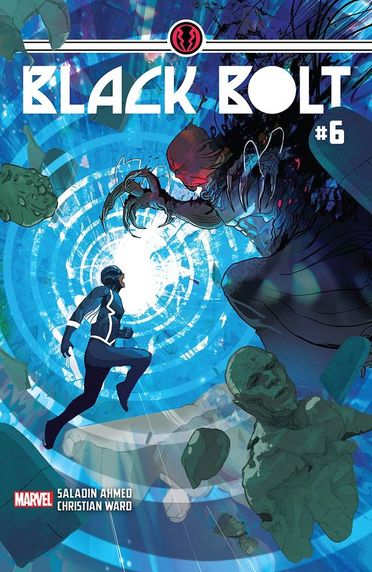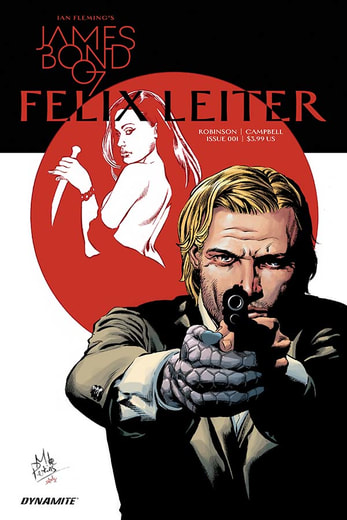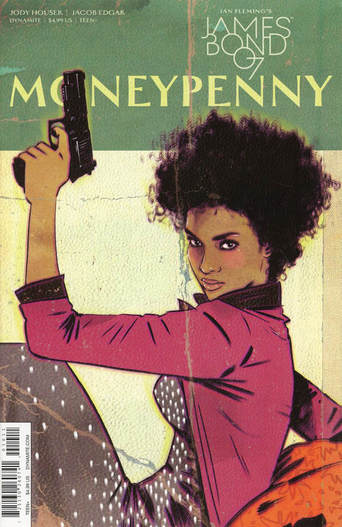Written by Joel T. Lewis Forget that this issue of Black Bolt is the climax of a six-issue run that has made me a Black Bolt fan. Forget that this series is also responsible for my new-found love for Crusher Creel, and forget that it concludes with a more compassionately motivated title character on an interstellar journey back to earth with his all-but-adopted alien daughter Blinky by his side. This issue is all about the artwork. As if sharing pages with, and damn-near outshining, comic veteran and guest artist Frazer Irving in issue five wasn’t enough, Christian Ward’s finale work blew me away this month. Throughout this series, Ward has gotten to play in a pretty large sandbox: here’s an interstellar prison, run by an ancient Inhuman psychic vampire where he can manipulate each inmate’s reality in order to intensify the suffering that he feeds off of. Oh, and here’s a nostalgic flashback section retelling the origin of Absorbing Man. Ward is as versatile as they come but the cosmic is where he lives, bringing the bizarre world of Black Bolt’s Prison, companions, and powers to dazzling life, dripping in blues and bathed in red light. In this issue we get to see the full force of Black Bolt’s powers as our familiar ragtag team of misfits confront the parasitic Jailer one last time, and in a series defined by excellent color work, Ward outdoes himself. I suppose I should have seen (Spoiler Upcoming) that Saladin Ahmed’s heartfelt tribute and character arc for Crusher Creel in this series was setting the B-lister up for a noble sacrifice but I didn’t and it hit me pretty hard. But what a way to go out! Realizing that none of their powers were able to effect the Jailer from behind Black Bolt’s shield, Creel decides to sacrifice himself for the good of his fellow inmates. He tells Blinky to use her telepathic powers to lure the Jailer into feeding off of his mind, but before that he tells Black Bolt to yell at him. Bolt, knowing that there is no other way, wails with all of his might at Creel and the Absorbing Man does what he does best and becomes the physical embodiment of Black Bolt’s scream. Luminous, saddened, but determined Crusher flies at the Jailer and sends him into oblivion in a sea of technicolor carnage that contrasts beautifully with the red-lit panels of the previous pages. This first arc of the Black Bolt series has come to a sad but satisfying conclusion as the deposed King of the Inhumans can now begin the long journey across the stars to retake his throne and reunite with his people. As each of the ragtag team bids the silent King farewell he is faced with a complicated decision: what’s to be done with Blinky? Here is where we really see the development that author Saladin Ahmed has weaved into Black Bolt’s character. Instead of a cold monarch’s decree that the child will have to return to her world, where she would be put to death, Black Bolt responds with a newfound softness, smiling quietly, saying yes. This first arc has been emotional, stunning, and terrifying. Marvel really has hooked into something special with the combination of Saladin Ahmed and Christian Ward and I’m thrilled to have been able to follow this series from its inception. To take the prison break trope and breathe such vibrant new life into it is really impressive and Ahmed pulled it off flawlessly. I cannot wait to see where this series goes next. I’ve seen some pretty exciting sneak peek posts from artist Frazer Irving who will be returning to the title and it will be a really interesting dynamic to see a storyline where Black Bolt and Blinky journey across the stars headed for Earth. I love Blinky and I’m so happy to see her story continue and maybe she’ll cross paths with Moon Girl and Devil Dinosaur soon! Are you enjoying Black Bolt? What are your thoughts on Absorbing Man? Please comment below or shoot me a message on Twitter @Joelt18. Until next time, Geek On!
0 Comments
Written by Joel T. Lewis  I didn’t get what I wanted from Dynamite’s Felix Leiter series. I wanted a series that showed that Leiter was every inch the American counterpart to James Bond. A competent, calculating, international man of mystery who orders Jack Daniels in the lobbies of exorbitant hotels because that’s what an American would do. This isn’t author James Robinson’s Felix Leiter. It is isn’t what I wanted. I got something better. Felix isn’t James Bond. He’s never been James Bond and the humanity author James Robinson contributes to the arc of a man constantly on the sidelines in Bond’s adventures is uplifting in a strange sad way. Maimed and no longer a member of the CIA, Leiter teams up with Japan’s super spy Tiger Tanaka on a straightforward mission, ID-ing a Russian spook whose history with Leiter went beyond professional admiration. At least on Leiter’s side. This seemingly simple recon mission expands into a conspiracy to start a war between North Korea and Japan. The method? Weaponized radical cultists who disintegrate and massacre everyone within breathing range. First of all, what a pairing! You Only Live Twice’s ninja-spy Tiger Tanaka and the CIA’s own Felix Leiter? Talk about two for one. Tiger is every bit the badass we got to see in the fourth Bond film. With his elite team of ninjas, Tanaka’s bold and decisive strikes as a leader and later as an operative himself are really satisfying to read. With a gun or katana, Tiger is a formidable agent who rivals James Bond’s innovation and brutality. In the middle of Tokyo’s vibrant Metropolis or the dead of night overlooking a private army’s compound, the Leiter series’ artwork leaps off every page. With lines and color conveying the noise or silence of Leiter’s surroundings, artist Aaron Campbell and Colorist Salvatore Aila execute each panel to perfection. With the ability to convey the size and scale of sweeping landscapes and the claustrophobia of hand to hand combat, Campbell and Aila make reading their series breathtaking and cinematic capturing intimacy and scale exceptionally.  But this 6 issue series (please Dynamite let there be more) really shines as a showcase for the sometimes bumbling Felix Leiter. Robbed of his right forearm and left leg (replaced by Bond-Villain level prosthetics), Leiter expresses his feelings of inadequacy when compared to the mighty Tanaka or the indestructible 007 throughout the series and you follow the arc of a man struggling for confidence and relevancy. And who wouldn’t question their worth surrounded by supermen like Tanaka and Bond who seem to artfully handle everything thrown at them and manage to walk away unscathed? Especially, as a man who bears the scars of missions past? Having led from the rear for much of his career, Leiter forces himself to take charge and infiltrates the web of intrigue surrounding the impending conflict between North Korea and Japan helped by Tanaka. Falling, dropping his gun, and even getting caught with an unloaded weapon at one point, Leiter’s spirit and determination move the plot of the series and you find it hard not to root for him. But your identification with his character doesn't come from a place of pity. It would have been all too easy for Robinson to lean into the maimed operative trope and make Felix tragic and pitiful, but at no point does Felix feel sorry for himself. He has a self-awareness of his limitations and where he stacks up next to Tanaka and Bond as an operative, but also the drive and desire to push those boundaries. This determination is especially evident in the climatic sequence toward the end of the series where Felix doesn't think and just reacts, taking out operatives in rough and tumble fashion that would do 007 proud. Leiter is in many ways the inverse of James Bond. He expresses lingering feelings for the Russian agent he's been sent to ID in a way that Bond never would, he doubts, he despairs, but he doesn't let any of his shortcomings prevent him from trying. Leiter also shines as a counterweight to the passionate rage of Tiger after a fatal misstep in the apprehension of a cult leader causes the majority of his personnel to perish. The American’s level-headedness allows Tanaka to clear his head and Leiter’s diligent surveillance work leads to a critical revelation about the forces behind the biological attacks. It's odd to think that the only Dynamite Bond titles I've read so far have been about supporting characters and I've yet to read any of those starring the man himself. If the Moneypenny one-shot and this Felix Leiter series are any indication, Dynamite comics have tapped into everything fun and compelling about the Bond films and the Bond expanded universe could not be in more capable hands. Until next time, Geek On! Written by Joel T. Lewis  As a massive James Bond fan, I’ve had the misfortune of remembering that Dynamite comics have been producing a handful of Bond Comics too late to follow them month to month. So, I have had to watch as issues of James Bond: Black Box, Kill Chain, Hammerhead, and Felix Leiter have come and gone and wait patiently for the trades to be released and the funds to invest in them. Missing out on the Felix Leiter series was particularly painful as I have a fond affection for the sometimes bumbling CIA agent. So, when I discovered in advance that there was going to be a Moneypenny one-shot, I was ecstatic and it was instantly added to my pull-list. If anybody affiliated with Dynamite Comics happens to be reading this, please give our girl a full-on series, because she kicks some major ass in this one-shot. Jody Houser’s one-shot does a great job balancing a fragmented origin story for Moneypenny with a present-day narrative describing her first security detail assignment after leaving field work. One of the most poignant flashbacks in this issue dealt with one of Moneypenny’s first memories of prejudice. After a group of bullies, led by a blonde-haired blue-eyed girl, at her primary school harass one of her middle-eastern school mates, implying that all people from that area are potential terrorists, Moneypenny’s attempt to comfort her friend has an unexpected response. In the girl’s bathroom later, Moneypenny asserts that the recent terror attacks that have gotten everyone up in arms have nothing to do with her friend or her family. Her friend responds passionately as she storms past, ‘I know that. I'm not the one you needed to say that to.’ It is a nuanced and powerful point that Jody Hauser makes about the power and context of words and the proper venues and strategies for standing up for the persecuted. By comforting her friend after the fact, Moneypenny acted out of compassion, but from a position of comfort (behind the closed doors of the girl's bathroom). But if she had stood up to the group of bullies as they were being cruel, the vulnerability of that position would have been a real testament to the ally Moneypenny was trying to be. This early experience shapes Moneypenny into a powerful and unapologetic adult, who does not bend towards convention and refuses to suffer bigotry. Moneypenny demonstrates this firm stance as a powerful woman of color as she calls out her the male members of her team for their misogynist and condescending statements about her refusal to join them for a drink on the job. The creative combination of colorist Dearbhla Kelly and artist Jacob Edgar showcase just how no-nonsense Moneypenny is as an operative. The way she views the world around her informs our perception of her as a highly skilled agent. Contrasting the location of exits, weapons, and tools with shades of red set against cooler tones of bluish greens to indicate neutral spaces in rooms, Kelly and Edgar show that whenever Moneypenny enters a room, she's instantly aware of the best object to use as a weapon and the quickest escape route. Though her reassignment from straight field work to head of security detail seems to irk Moneypenny, the man she is assigned to guard assures her of her worth and competence and the tired trope of ‘undervalued agent lowered to babysitting’ is quickly disarmed. Moneypenny takes this new assignment very seriously, and it's a good thing too. Following a speech by the man her subject traveled to see, Moneypenny notices an eerie absence of students moving about on the college campus and proceeds to dismantle a large team of operatives aiming to kill her subject. I don't want to go into too much detail about this powerhouse sequence at the end of this issue but I will say that this creative team shows Moneypenny to be every bit as competent, efficient, and clever an operative as James Bond and don't forget: she's doing it all in heels! Comics need more strong bad-ass women of color as their focus, and Moneypenny is a great example of a character who can carry her own series in a universe dominated by male agents. Move over James, it's Moneypenny’s turn! Until next time, Geek On! |
Archives
May 2024
|
|
© 2012-2025, Nerds That Geek LLC.
All Rights Reserved. |
uWeb Hosting by FatCow
